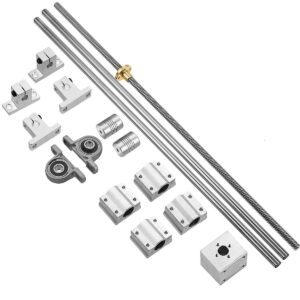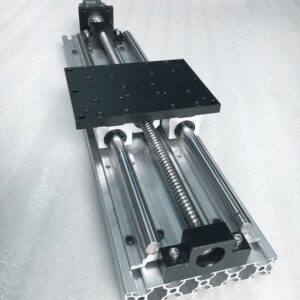Precision movement lies at the heart of modern engineering. From robotic arms assembling microchips to massive CNC machines carving aerospace parts, linear motion components ensure that everything moves with exact accuracy, stability, and reliability. These components are the unseen heroes that make automation smooth, machines efficient, and technology smarter.
In this detailed guide, we’ll explore everything about linear motion components—what they are, how they work, their different types, applications, and how to choose the right ones for your system.
Understanding Linear Motion Components
Linear motion components are mechanical parts designed to move loads in a straight line with controlled speed, direction, and accuracy. Unlike rotational motion (like gears or shafts), linear motion deals with forward or backward movement along a single axis.
These components convert rotary motion from motors into linear displacement, allowing precise movement in machines, automation systems, and robotics.
Whether in semiconductor production, packaging, or 3D printing, linear motion components guarantee consistent performance, reduced friction, and prolonged machine life.
Core Components of a Linear Motion System
Every linear motion setup relies on a combination of interconnected components that work in harmony. Let’s break them down:
Linear Guides (Rails): Provide the path for movement, ensuring stability and precision.
Linear Bearings: Enable smooth sliding or rolling motion with minimal friction.
Linear Actuators: Convert rotary motor motion into linear displacement.
Ball Screws and Lead Screws: Offer high-efficiency mechanical conversion.
Linear Motors: Provide direct, frictionless linear drive.
Couplings: Connect motor shafts to screws or actuators.
Support Units and End Blocks: Maintain alignment and structural integrity.
Together, these elements form the backbone of any precision motion system.
Linear Guides: The Backbone of Precision
Linear guides—often called linear rails—serve as the tracks that guide motion. They maintain straightness and absorb loads in multiple directions.
Two primary types dominate the market:
Ball Guides: Use recirculating balls for low friction and smooth movement.
Roller Guides: Use cylindrical rollers for greater load capacity and rigidity.
Applications range from medical scanners to industrial robots. Their strength lies in high accuracy, durability, and resistance to vibration.
Linear Bearings and Bushings
Linear bearings are the components that slide along a shaft or guide rail, ensuring smooth linear motion. They can be either recirculating (using rolling elements like balls) or plain (using low-friction materials like PTFE).
Popular types include:
Linear Ball Bearings: For low-friction precision motion.
Plain Bushings: Ideal for dusty or harsh environments.
Self-Lubricating Bearings: Reduce maintenance needs.
They minimize wear and energy loss while maintaining accuracy under dynamic conditions.
Linear Actuators: Motion in Action
At the heart of movement is the linear actuator, responsible for converting energy (usually electric or pneumatic) into controlled linear motion.
Common types include:
Electric Actuators: Powered by servo or stepper motors for precise control.
Hydraulic Actuators: Provide high force for heavy-duty operations.
Pneumatic Actuators: Offer fast, cost-effective linear motion for automation.
Linear actuators are widely used in factory automation, robotics, and packaging systems where accurate positioning is essential.
Ball Screws and Lead Screws
These screws are the mechanical bridge between rotary and linear motion.
Ball Screws: Feature ball bearings that roll between the screw shaft and nut, reducing friction and improving efficiency (up to 90%).
Lead Screws: Simpler design using direct thread contact, suitable for lower speed and load applications.
Ball screws are ideal for CNC machines and robotics, while lead screws shine in quiet, compact systems like medical devices.
Linear Motors: The Future of Direct Drive
Unlike ball screws or belts, linear motors directly generate linear motion without mechanical transmission.
Advantages include:
Zero backlash
High acceleration
Minimal maintenance
Smooth, silent operation
These motors are increasingly common in high-speed production lines, semiconductor equipment, and 3D printers where rapid, precise positioning is crucial.
Couplings and Support Units
Even the most sophisticated motion system requires proper alignment and mechanical stability.
Couplings connect rotating shafts, compensating for misalignment and reducing vibration.
Support Units anchor and stabilize the ends of ball screws or shafts, ensuring smooth operation.
Without these “silent” components, precision and reliability would quickly degrade.
Linear Motion Components in Automation
Automation relies heavily on linear motion components for efficiency and repeatability. From automotive assembly lines to packaging and inspection systems, these components drive:
Conveyor movement
Robotic arm positioning
Material transfer systems
Precision cutting and welding
Linear motion systems form the foundation of Industry 4.0, ensuring accuracy, flexibility, and reduced human intervention.
Key Performance Factors
When selecting linear motion components, performance parameters matter. Consider these essential factors:
Load Capacity: Determines the system’s weight-bearing ability.
Speed: Affects productivity and precision.
Accuracy and Repeatability: Essential for precision manufacturing.
Rigidity: Prevents vibration or bending under stress.
Friction and Wear: Dictate efficiency and lifespan.
Maintenance Requirements: Influence cost and uptime.
Balancing these factors ensures both performance and longevity of the motion system.
Linear Motion Components vs Rotary Systems
| Feature | Linear Motion | Rotary Motion |
|---|---|---|
| Direction | Straight-line movement | Circular movement |
| Components | Rails, guides, actuators | Shafts, gears, bearings |
| Speed | Moderate | High |
| Accuracy | Extremely precise | Depends on design |
| Applications | Robotics, CNC, automation | Motors, turbines, wheels |
Linear systems prioritize precision and stability, while rotary systems excel in speed and continuous motion.
Materials Used in Linear Motion Components
The materials define durability and performance:
Alloy Steel: For rails and screws requiring high strength.
Aluminum: Lightweight, corrosion-resistant for compact systems.
Stainless Steel: Excellent for cleanroom or corrosive environments.
Engineering Plastics (PTFE, POM): Used in bushings for self-lubrication.
Each material contributes differently to friction reduction, load handling, and system longevity.
Lubrication and Maintenance
Smooth operation depends on proper lubrication. It minimizes wear, reduces noise, and extends service life.
Best practices:
Use manufacturer-recommended grease or oil.
Apply lubrication periodically (manual or automatic).
Avoid over-lubrication — it attracts contaminants.
Check seals and wipers regularly.
Modern systems often feature self-lubricating designs for maintenance-free operation.
Environmental Protection and Sealing
Industrial environments can be harsh. Dust, chips, and fluids easily damage precision components. Hence, sealing and protection are vital.
Protective measures include:
End seals and scrapers
Bellows or covers over rails
Corrosion-resistant coatings
Vacuum-compatible materials for cleanrooms
Proper protection ensures consistent operation even in challenging surroundings.
Precision in Motion Control
Precision defines the difference between an average system and a world-class machine. High-end linear motion systems achieve micron-level accuracy, critical in applications like semiconductor lithography or laser engraving.
Factors influencing precision:
Alignment accuracy
Guide preload
Material stiffness
Temperature control
Every micron matters in industries where perfection is the standard.
Applications of Linear Motion Components
Linear motion components are everywhere — though often unseen. Common applications include:
CNC Machines: Positioning cutting tools with micron accuracy.
3D Printers: Guiding print heads smoothly across axes.
Medical Devices: Precision scanning and imaging.
Industrial Robotics: Controlled, repeatable movements.
Packaging Equipment: High-speed, accurate transfer of goods.
Automotive Assembly Lines: Consistent mechanical motion.
From micro-movements to massive machinery, linear motion drives innovation.
Advantages of Linear Motion Components
High Precision and Repeatability
Low Friction and Wear
Compact Design with High Strength
Long Service Life
Minimal Maintenance
Adaptability Across Industries
They’re the secret behind faster production, better energy efficiency, and reduced human error in industrial systems.
Selecting the Right Linear Motion Components
When designing or upgrading your motion system, consider:
The load type (axial, radial, or combined)
Desired travel speed and distance
Precision requirements (micron-level or general accuracy)
Operating environment (cleanroom or dusty factory)
Budget and maintenance preferences
Matching these factors ensures a reliable, cost-effective motion setup.

Innovations in Linear Motion Technology
Modern advancements continue to refine performance:
Smart Linear Guides: Sensors detect wear and preload changes.
Self-Lubricating Bearings: Extend operation time between maintenance.
Compact Linear Motors: Offer faster acceleration.
Digital Feedback Systems: Enable real-time position control.
Eco-Friendly Designs: Use recyclable materials and dry lubrication.
Innovation ensures linear motion systems stay efficient, smart, and sustainable.
Future of Linear Motion Components
The future points toward intelligent, lightweight, and interconnected systems.
IoT-Enabled Guides: Monitor health remotely.
AI-Based Control: Predict maintenance and optimize motion paths.
Carbon Fiber Structures: Reduce weight and increase stiffness.
Magnetic Levitation Drives: Eliminate contact and wear.
Tomorrow’s motion components will think, adapt, and sustain themselves — reshaping how industries move.
Linear Motion Components
At their core, linear motion components embody the essence of precision and progress. They’re the hidden foundation of every advanced technology, ensuring machines move exactly as intended—smoothly, accurately, and efficiently.
As automation, robotics, and manufacturing continue to advance, the importance of these components will only grow, bridging the gap between innovation and reality.
Frequently Asked Questions
What are linear motion components?
They are mechanical parts that enable precise straight-line movement in machinery and automation systems.
What are the main types of linear motion components?
Linear guides, bearings, actuators, ball screws, and motors.
Why are linear guides important?
They provide the stability and accuracy needed for precise motion without frictional wear.
What is the difference between a ball screw and a lead screw?
Ball screws use recirculating balls for higher efficiency, while lead screws rely on thread contact for quieter, simpler operation.
Can linear motion components operate in harsh environments?
Yes, with proper sealing, lubrication, and corrosion protection.
Do linear motion systems require maintenance?
Minimal maintenance is needed if they’re properly lubricated and protected from contaminants.
Conclusion
Linear motion components are the lifeblood of today’s precision-driven world. Their ability to deliver smooth, accurate, and reliable motion defines success in modern automation, robotics, and manufacturing.
Whether you’re designing a CNC machine or an automated production line, choosing the right linear motion components ensures your system’s performance, longevity, and efficiency. In a world where every micron matters, these components keep innovation moving — quite literally.
Inbound Link Suggestions
Link to: “Understanding Ball Screw Mechanisms for Linear Motion”
Link to: “Top Maintenance Tips for Linear Guides and Bearings”
Outbound Link Suggestions
Link to: “How Linear Motion Systems Power Industry 4.0”
Link to: “Selecting the Best Linear Actuator for Your Application”



